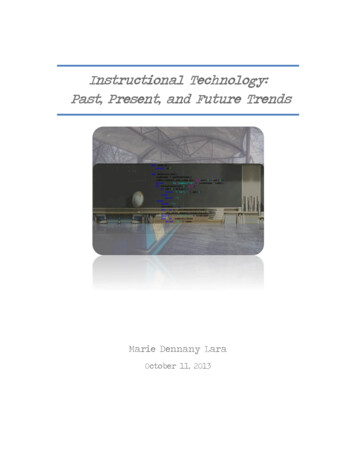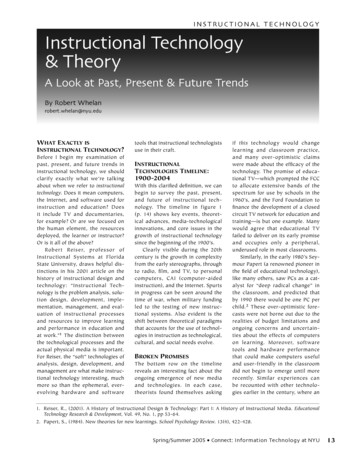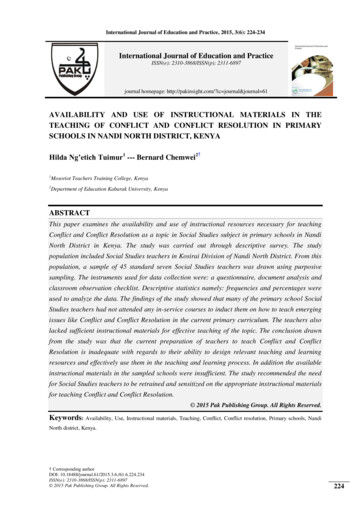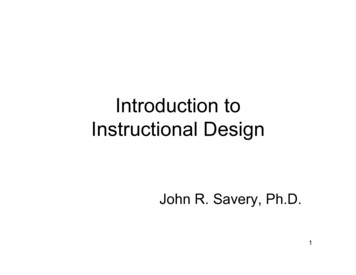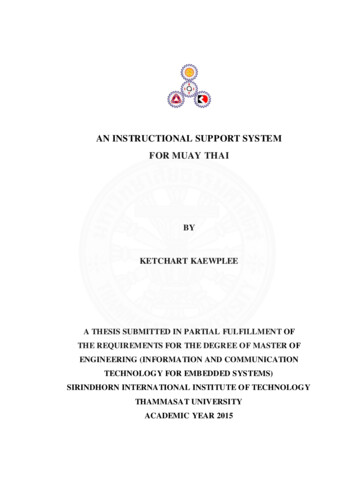
Transcription
AN INSTRUCTIONAL SUPPORT SYSTEMFOR MUAY THAIBYKETCHART KAEWPLEEA THESIS SUBMITTED IN PARTIAL FULFILLMENT OFTHE REQUIREMENTS FOR THE DEGREE OF MASTER OFENGINEERING (INFORMATION AND COMMUNICATIONTECHNOLOGY FOR EMBEDDED SYSTEMS)SIRINDHORN INTERNATIONAL INSTITUTE OF TECHNOLOGYTHAMMASAT UNIVERSITYACADEMIC YEAR 2015
AN INSTRUCTIONAL SUPPORT SYSTEMFOR MUAY THAIBYKETCHART KAEWPLEEA THESIS SUBMITTED IN PARTIAL FULFILLMENT OFTHE REQUIREMENTS FOR THE DEGREE OF MASTER OFENGINEERING (INFORMATION AND COMMUNICATIONTECHNOLOGY FOR EMBEDDED SYSTEMS)SIRINDHORN INTERNATIONAL INSTITUTE OF TECHNOLOGYTHAMMASAT UNIVERSITYACADEMIC YEAR 2015
AcknowledgementsThis research is supported by Thammasat University Research Fund2012, Thailand Advanced Institute of Science and Technology (TAIST), NationalScience and Technology Development Agency (NSTDA), Tokyo Institute ofTechnology and Sirindhorn International Institute of Techcnology (SIIT), ThammasatUniversity (TU) and the National Research University Project, Thailand Office ofHigher Education Commission.ii
AbstractAN INSTRUCTIONAL SUPPORT SYSTEM FOR MUAY THAIbyKETCHART KAEWPLEEBachelor of Electrical Engineering, Chulalongkorn University, 2011M.Eng (Information and Communication Technology for Embedded Systems),Sirindhorn International Institute of Technology Thammasat University, 2015An Instructional Support System for Muay Thai is a program that is inthe form of a game. Training data is collected from Muay Thai Professional boxers.The aim of the program is to make people understand Muay Thai by self- learningpractice. The user watches a maneuver animation and performs the maneuver. Then,our program will show the performance result. This program uses skeleton datacontained by the Microsoft Kinect. Because there are different organ lengths fromdifferent people, the system focuses on an angle of joints of each organ. In this thesis,we also propose algorithms which are Depth Tracking and Boundary Adjustment toimprove the rate of skeleton recognition. With the Kinect recognition system alone,the accuracy of skeleton recognitions of all 24 standard Muay Thai maneuvers is 51%.After applying our proposed algorithms, we are able to bring the accuracy up 26%. Onaverage, our proposed algorithms along with the Kinect recognition system yieldsaccuracy of 77% on average standard Muay Thai maneuvers.Keywords : Instruction Support System, Muay Thai, Kinectiii
Table of ContentsChapterTitlePageSignature PageiAcknowledgementsiiAbstractiiiTable of ContentsivList of Figures12viiiIntroduction11.1 Motivation11.2 Objective11.3 Expected Outcome11.4 Scope and Limitation11.5 Structure of the thesis2Literature Review32.1 Muay Thai32.1.1 Lead Straight Punch (LSP)32.1.2 Rear Straight Punch (RSP)42.1.3 Lead Upper Punch (LUP)42.1.4 Rear Upper Punch (RUP)42.1.5 Lead Hook Punch (LHP)42.1.6 Rear Hook Punch (RHP)52.1.7 Side Foot-Thrust (SFT)52.1.8 Lead Foot-Thrust (LFT)52.1.9 Rear Foot-Thrust (RFT)62.1.10 Lead Front Kick (LFK)62.1.11 Rear Front Kick (RFK)6iv
2.1.12 Lead Low Round Kick (LLRK)62.1.13 Rear Low Round Kick (RLRK)72.1.14 Lead High Round Kick (LHRK)72.1.15 Rear High Round Kick (RHRK)72.1.16 Swing Knee (SK)72.1.17 Low Straight Knee (LSK)72.1.18 High Straight Knee (HSK)82.1.19 Lead Shooting Elbow (LSE)82.1.20 Rear Shooting Elbow (RSE)82.1.21 Lead Downward Elbow (LDE)82.1.22 Rear Downward Elbow (RDE)82.1.23 Lead Round Elbow (LRE)82.1.24 Rear Round Elbow (RRE)92.2 Related Work92.2.1 Martial Arts in Artificial Reality [4]92.2.2 A Kinect based Golf Swing Score and Grade SystemUsing GMM and SVM [1]102.2.3 Game Based Approach to Learn Martial Arts for Beginners [2]112.2.4 Edutainment - Thai Art of Self- Defense and Boxingby Motion Capture Technique [3]112.3 Kinect122.3.1 Kinect Data132.4 Techniques used in this system162.4.1 Dynamic Time Warping (DTW)162.4.2 Sliding Window Dynamic Time Warping (SW DTW)172.4.3 Hidden Markov Model (HMM)172.4.4 Baum–Welch Algorithm182.4.5 K-Nearest Neighbors Algorithm(k-NN)202.4.6 Hierarchical Clustering21v
34A Rule-based Approach for Improving Kinect Skeletal Tracking233.1 False Skeleton Problem233.1.1 Dead Limb233.1.2 Swap233.1.3 Short-Coming243.2 Methodology263.3 Experiment283.4 Results & Discussion283.5 Summary30Maneuver Similarity Measurement334.1 The Processes for Maneuver Similarity Measurement334.2 Feature Extraction334.3 Maneuver Similarity Measurement344.3.1 Dynamic Time Warping (DTW)354.3.2 Sliding Window (SW)364.3.3 Hidden Markov Model (HMM)374.3.4 Weighted Separated Body Part (WSBP)374.4 Experiment Setup394.5 HMM Fine-tuning424.6 Experiment Results434.7 Result Analysis514.7.1 DTW: Standard Kinect514.7.2 DTW: Kinect 514.7.3 SW: Standard Kinect524.7.4 SW: Kinect 524.7.5 HMM: Standard Kinect534.7.6 HMM: Kinect 534.7.7 WSBP DTW: Standard Kinect (Weight 4)534.7.8 WSBP DTW: Kinect (Weight 3)53vi
564.7.8 WSBP DTW: Kinect (Weight 3)534.7.9 WSBP SW: Standard Kinect (Weight 3)544.7.10 WSBP SW: Kinect (Weight 5)544.7.11 WSBP HMM Standard Kinect (Weight 5)554.7.12 WSBP HMM Kinect (Weight 4)554.8 Summary68INSTRUCTIONAL SUPPORT SYSTEM FOR MUAY THAI695.1 Body-based Control715.2 Single Maneuver Training725.3 Multiple Maneuvers Training765.4 ix A - List of Publications83vii
List of FiguresFiguresPage2.1 Lead Straight Punch and Rear Straight Punch32.2 Muay Thai92.3 Martial Arts in Artificial Reality102.4 A Kinect based Golf Swing Score and Grade System Using GMMand SVM102.5 Game Based Approach to Learn Martial Arts for Beginners112.6 Edutainment - Thai Art of Self- Defense and Boxing by Motion Capture Technique122.7 Kinect This picture is from aspx122.8 Joints This picture is from aspx132.9 Bone142.10 Absolute Bone Rotation152.11 Hierarchical Bone Rotation163.1 Skeleton images of a Rear High Round Kick maneuver by Kinectrecognition system. The top image displays a side- view of the bottomimage.243.2 Skeleton images of a Lead Foot-Thrust maneuver by Kinect recognition system. The top image displays a side-view of the bottomimage.253.3 Skeleton images of a Rear Front Kick maneuver by Kinect recognitionsystem. The top image displays a side- view of the bottom image.253.4 Skeleton images of a Side Foot-Thrust recognition maneuver by KinectSkeleton Tracking system.263.5 Skeleton data the video in Fig. 3.1. The first frame is the result fromthe Kinect Skeleton Tracking system alone. The second frame is theresult after depth tracking. The third frame is the result from thedepth tracking and boundary adjustment. The top frames are theviii
side view of the bottom frames.303.6 Skeleton data the video in Fig. 3.2. The first frame is the result fromthe Kinect Skeleton Tracking system alone. The second frame is theresult after depth tracking. The third frame is the result from thedepth tracking and boundary adjustment. The top frames are theside view of the bottom frames.313.7 Skeleton data the video in Fig. 3.3. The first frame is the result fromthe Kinect Skeleton Tracking system alone. The second frame is theresult after depth tracking. The third frame is the result from thedepth tracking and boundary adjustment. The top frames are theside view of the bottom frames.313.8 Skeleton data the video in Fig. 3.4. The top frame is the result fromthe Kinect Skeleton Tracking system alone. The middle frame is theresult after depth tracking. The bottom frame is the result from thedepth tracking and boundary adjustment.324.1 Maneuver Similarity Measurement Diagram344.2 Experiment Setup Step 1394.3 Experiment Setup Step 2404.4 Experiment Setup Step 3414.5 Experiment Setup Step 4414.6 Experiment Setup Step 5424.7 HMM Kinect Fine-tuning424.8 HMM Kinect Fine-tuning424.9 WSBP HMM Kinect Fine-tuning434.10 WSBP HMM Kinect Fine-tuning435.1 System Flowchart705.2 Player Calibration705.3 Menu715.4 Introduction Screen725.5 Maneuver Select735.6 Sample Maneuver Animation735.7 Stand by!!74ix
5.8 Ready!!745.9 Go!!755.10 Analyzing755.11 Result Screen765.12 Multiple Maneuvers Training Ready Screen775.13 Multiple Maneuvers Training Perform Screen785.14 Multiple Maneuvers Training Result Screen78x
Chapter 1Introduction1.1MotivationThe appearance of the Microsoft Kinect makes us realize the potential of motionsensing input device. The Microsoft Kinect recognition in frame per second is veryhigh. So, the Microsoft Kinect can be used to control a character in a fighting gamebetter than a game controller which has about 10-20 buttons. There are a lot ofmartial arts fighting games. Muay Thai is a combat that use the full function ofhuman body. It uses a hand, elbow, knee, and foot. Consequently, we are interestedin making an instructional program to teach Muay Thai using the Microsoft Kinect.1.2ObjectiveIt is our goal to make an Instruction Support System for Muay Thai that, The program must be able to capture player's movements correctly. The program can calculate an accuracy of a movement compared to a givenMuay Thai maneuver. The training set of this program is collected from professional Muay Thaimasters.1.3Expecte d OutcomeThe expected outcome of this thesis is an Instruction Support System for MuayThai that is easy to use and understand. The player can use it individually. We willmake an Instruction Support System for Muay Thai as a self- learning program.1.4Scope and LimitationThe Microsoft Kinect can not recognize a hidden parts of an object. The out ofthe line of sight may cause a problem in the Microsoft Kinect skeletal tracking. Wewill make an algorithm to improve skeletal tracking with only one Microsoft Kinectused in our system. The algorithm will be able to predict the position of a hiddenorgan when the out of the line of sight problem appears. The algorithm will use the1
1.5Structure of the thesisThis thesis contains 6 chapters.Chapter 1: IntroductionThis chapter serves as an introduction to our project.Chapter 2: Literature reviewThis chapter reviews previous works and techniques used.Chapter 3: A Rule-based Approach for Improving Kinect SkeletalTrackingThis chapter introduces various skeletal tracking problems and how we improvethem.Chapter 4: Maneuvers RecognitionThis chapter will show all result of maneuvers recognition by our proposed algorithms.Chapter 5: AN INSTRUCTIONAL SUPPORT SYSTEM FOR MUAY THAIThis chapter will describe our program and it performance.Chapter 6: ConclusionThis chapter will summarize the entire of this project and direction.2
Chapter 2Literature Review2.1Muay ThaiMuay Thai [5] is a type of martial arts used in Thailand. It is known also as "theart of eight limbs" because both sides of hands, elbows, knees, and legs can be usedto attack an opponent. Muay Thai has more than two hundred fighting techniques. Itsmaneuvers are a combination of fists, elbows, knees, shins and feet, which makes adeadly combat.Muay Thai has more than 200 maneuvers, but there are only a few standard maneuvers. In this thesis, we present 24 standard maneuvers which refer to "Mae MaiMuay Thai The Art of Self- Defense"[6]. Standard Muay Thai maneuvers have thelead and rear maneuvers as shown in figure 2.1. The lead maneuvers use the bodyparts which are close to the opponent. The rear maneuvers use the body parts whichare far away from the opponent.Figure 2.1: Lead Straight Punch and Rear Straight Punch2.1.1 Lead Straight Punch (LSP)The Lead Straight Punch maneuver is the striking punch with the fist fromthe shoulder level straight to the target. LSP is the punch of the leading fistthrowing directly to the target by forces from the shoulder of the upright bodywhile the feet are pushing against the floor. The feet do not move, but theweight is always transferred to the leading foot after throwing the punch.3
2.1.2 Rear Straight Punch (RSP)The Rear Straight Punch maneuver is the punch of rear fist of the fightingposture throwing directly to the target by forces from the shoulder, trunk, andfeet. When launching the punch, the trunk, waist and hip will rotate forwardwith forces driven by the rear foot. The body weight is on the leading foot.2.1.3 Lead Uppe r Punch (LUP)The Lead Upper Punch maneuver is a swinging punch vertically directedupward with a bent, flexed elbow and a face-up fist. The Lead Upper Punchmaneuver is best for striking at close quarters when the opponent is loweringhis head. The landing targets are the opponent's chin, abdomen, chest, and face.The Lead Upper Punch maneuver is executed with the leading hand afterengaging at close quarters. The boxer slightly bends his knees down with feetapart, lower his face- up lead fist and twist his body before launching the punchstraight upward vertically. The rear arm is pulled by the rotation force. The leadfoot is pushing the floor while stretching the body with the launching punch.The force of the punch depends on the flexing arm, the twist of the body, thetwitch of the left arm and most importantly the stretching leg of the pushing footagainst the floor.2.1.4 Rear Uppe r Punch (RUP)The Rear Upper Punch maneuver is executed with the rear hand. Theboxer bends his rear knee down, twists his body, hip and shoulder to the otherside before twitchingly launching the face-up fist of the flexing arm. The leadshoulder and lead fist must be punching quickly at the same time as the rear fistis launched.2.1.5 Lead Hook Punch (LHP)The Lead Hook Punch maneuver is the strike of the lead fist in the fightingposture. The boxer slightly bends his knees and twists his body to the otherside, pushing the foot against the floor, dropping his lead arm at full stretch with4
the face-down fist before turning the rear arm and rear shoulder and swinginghorizontally. The landing target is hit with the knuckle which is reinforced bythe waist, trunk, shoulder, arm and lead fist while the body weight transferredfrom the rear foot to the lead foot.2.1.6 Rear Hook Punch (RHP)The Rear Hook Punch maneuver is executed with the rear hand. The boxerbends both knees and twists his hip, body and shoulder to the other side,stretches his rear arm away with the face-down fist and turns his lead arm beforeswinging the rear fist horizontally while the body weight is transferred from rearfoot to the lead foot. The magnitude of force from the twisting of the body, hipand shoulder depends on the pushing feet against the floor, the body weighttransferred the twitch of lead arm and the swing of the flexed rear arm.2.1.7 Side Foot-Thrust (SFT)The Side Foot-Thrust maneuver can be used as an ofensive tactic by thrustingwith a foot targeting the upper part of the opponent's body such as chin, chest orabdomen, leaving him no chance to fight back after being pushed far behind.This can also be used as a defensive tactic. The Side Foot-Thrust maneuverrequires a sideways twist of the body before delivery. The bent leg suddenlyflicks forward to hit the target with its heel while the body weight is transferredto the standing leg.2.1.8 Lead Foot-Thrust (LFT)The Lead Foot-Thrust maneuver is the forward foot-thrust with toe curlingto strike the opponent with the lead foot knuckles and heels. The landing targetcan be above or below the opponent's thigh or waist. Before launching the strike,the boxer stands upright to bluf the opponent, and moves around slightly to beready on both feet consciously. The Lead Foot-Thrust can be used as a tacticalofense to put the opponent of-balance before attacking with another maneuver,or as a counterattack when the opponent makes a rush move and opens gaps. Forexample, if the opponent delivers the low round kick, the boxer can use the Lead5
Foot-Thrust to counterattack at his kicking thigh, groin, or chest. Even when theopponent is well guarded, The Lead Foot-Thrust can be used to poke at theopponent's abdomen or groin, making him of- guard to parry it and opening thegap around the upper part of his body.2.1.9 Rear Foot-Thrust (RFT)The Rear Foot- Thrust maneuver is the forward foot-thrust with toe curlingto strike the opponent with the rear foot knuckles and heels which similar to theLead Foot-Thrust maneuver.2.1.10 Lead Front Kick (LFK)The Lead Front Kick maneuver is executed by lifting the knee straight forward, while keeping the foot and shin either hanging freely or pulled to the hip,and then straightening the leg in front of the opponent and striking the targetarea. It is desirable to retract the leg immediately after delivering the kick, toavoid the opponent trying to grapple the leg and to return to stable fightingstance.2.1.11 Rear Front Kick (RFK)The Rear Front Kick maneuver is the movement of the rear leg from its kneedown to the end of its foot to strike the target which is similar to the Lead FrontKick maneuver.2.1.12 Lead Low Round Kick (LLRK)The Lead Low Round Kick maneuver is a kick in which the boxer swings hisor her leg around in a semicircular motion, striking with the front of the leg orfoot. This type of kick is utilized in many diferent martial arts and is popular inboth non-contact and full-contact martial arts competitions.2.1.13 Rear Low Round Kick (RLRK)The Rear Low Round Kick maneuver is the maneuver that the rear leg move6
ment is curving up and striking horizontally which is similar to the Lead LowRound Kick maneuver.2.1.14 Lead High Round Kick (LHRK)The Lead High Round Kick maneuver is executed at the head height requiresthe boxer to torque around the hip as a fulcrum. Traditional stylists would preferto keep their weights firmly under their hips and do short range kicks and retaintheir abilities to counter a strike. The Lead High Round Kick maneuver requiresthe boxer to raise the center of gravity somewhat, tilt the hip, lean back andswing the lead leg forward.2.1.15 Rear High Round Kick (RHRK)The Rear High Round Kick maneuver is the maneuver that the rear legmovement is curving up and striking horizontally which is similar to the LeadHigh Round Kick maneuver.2.1.16 Swing Knee (SK)In the Swing Knee maneuver, the knee is executed by twisting the hip forwardto swing the knee strike down to the target. The foot tip, the knee, and the thighof the standing leg must align in a straight line.2.1.17 Low Straight Knee (LSK)To execute the Low Straight Knee maneuver, the body weight is mainly onthe rear foot. The boxer transfers his weight to the lead foot. When the footfirmly touches the ground, the boxer raises the lead knee up directly whiletransferring the weight back to the rear foot and augmenting force to the strikingknee. The sudden tightening of abdominal muscle that pulls the knee up willdrive the strike straight ahead, this is good for engaging at close quarters,clinching or yanking the opponent toward the strike.2.1.18 High Straight Knee (HSK)The High Straight Knee maneuver is similar to Low Straight Knee maneuver,7
but High Straight Knee maneuver raises the lead knee up much higher.2.1.19 Lead Shooting Elbow (LSE)The Lead Shooting Elbow maneuver is the strike where the bending leadelbow points straight to the opponent or in the direction of incoming attack. Thelead arm of the striking elbow must be flexed and kept close to the chin,shoulder and head to reinforce an impact on the opponent's forehead, eyebrows,eyes, nose, mouth, chin, chest, shoulder and abdomen.2.1.20 Rear Shooting Elbow (RSE)The Rear Shooting Elbow maneuver is similar to Lead Shooting Elbow maneuver, but Rear Shooting Elbow maneuver uses the rear elbow maneuver.2.1.21 Lead Downward Elbow (LDE)The Lead Downward Elbow maneuver is executed with the lead elbow. Thefighter raises his lead elbow up high and twists his body and his lead shoulder tothe other side before throwing the elbow down to the target while transferringthe body weight from the rear foot to the lead foot. The violence of the strikedepends on the force from pushing the feet against the floor, the twist of body,the twitch of arm and shoulder, the raising of the elbow, and the quickness ofstrike.2.1.22 Rear Downward Elbow (RDE)The Rear Downward Elbow maneuver is similar to the Lead DownwardElbow maneuver, but the Rear Downward Elbow maneuver uses the rear elbow.2.1.23 Lead Round Elbow (LRE)To execute the Lead Round Elbow maneuver, the boxer bends his lead kneedown and throws the lead elbow horizontally to the other side while stretchingthe knee to transfer the weight to the lead foot and the lead elbow. The body andrear shoulder are twisted to the other side. These movements must be done in atwitch all at once to reinforce the strike. The violence of the strike depends on8
the force from pushing the feet against floor, the transfer weight to the lead footand lead elbow, and the twist of body and shoulder, the swing of the elbow, thestretch of shoulder, abdomen and rear arm. The landing targets of Lead RoundElbow are the opponent's chin, lip, nose, eyes, eyebrows, forehead, and temples.2.1.24 Rear Round Elbow (RRE)The Rear Round Elbow maneuver is similar to the Lead Round Elbow maneuver, but the Rear Round Elbow maneuver uses the rear elbow.Figure 2.2: Muay Thai2.2Related Work2.2.1 Martial Arts in Artificial Reality [4]This paper presents an artificial reality martial arts game installation as shownin Figure 2.3, together with the results and observations from testing the game.With real-time image processing and computer vision, the video image of theuser is embedded inside 3D graphics on a virtual playfield facing virtualopponents. Collisions are detected between enemies and the outline pixels of theuser. The velocity of the outline pixels is estimated using the OpenCVimplementation of pyramidal Lucas-Kanade optical flow. This technique focuson the player hitting the target. It was not designed to recognize the entire body9
movement. Therefore, it is not suitable for Muay Thai maneuvers which areconsider many body parts.Figure 2.3: Martial Arts in Artificial Reality2.2.2 A Kinect based Golf Swing Score and Grade System Using GMMIn this work, Kinect is used to capture skeleton data from a user. A vectorquantization is used to transform the data to symbol sequence. The Serial correlation GMM model and GMM-KL divergence kernel are used to evaluate andrecognize the grade of Golf Swing as shown in Figure 2.4 These methods separate the extracted data from skeleton data into states of movements and evaluatethem separated by Kullback-Leibler divergence and grade them by Support Vector Machine. These methods only recognize velocity and angle on single joint.This technique can not applied to Muay Thai maneuvers because, in a standardmaneuver several joints must be considered.Figure 2.4: A Kinect based Golf Swing Score and Grade System Using GMMand SVM2.2.3 Game Based Approach to Learn Martial Arts for Beginners [2]In this paper, the composers introduce an interactive digital system that pro10
mote informal learning of martial arts, Karate, with the aid of Kinect as shown infigure 2.5. They explain that Kinect is a good device for camera motion trackingbecause Kinect price is relatively cheap compared to other available 3D sensorsin the market, Kinect does not require to put the sensor on player's body andKinect provides 3D data modeling which reduces their computation wo rk. Thecomposers propose a system with four steps of the method of Kinect interactionwith the user. Firstly, Kinect with NITE middleware captures player position.Secondly, The system identifies player's joint positions. Thirdly, the system calculates the accuracy of player maneuver by measuring the diferent anglebetween player position and correct position from the definition of karate.Finally, The system instructs the player to improve maneuver accuracy byconveying the tips. The score of maneuver accuracy is announced in this step. Inthis work, the ma- neuver accuracy was calculated using the diferent anglebetween player position and correct position from the definition of karate.However, the out of line sight problems can occur during the accuracycalculation. This calculation will be less efective when it is used with Muay Thaimaneuvers which have a lot of rotation movement that causes the out of line ofsight problems.Figure 2.5: Game Based Approach to Learn Martial Arts forBeginners2.2.4 Edutainme nt - Thai Art of Self-Defense and Boxing by MotionCapture Technique [3]This work uses 9 optical motion capture cameras and 42 sensor spot in both 2actors to capture data as shown in Figure 2.6. Though the movement data is11
more precise, this technique is expensive and not practical. The 3D animationsshow highly detail about Muay Thai movement. This software is not aninteractive program. Users only can watch the animations.Figure 2.6: Edutainment - Thai Art of Self-Defense and Boxing by MotionCapture Technique2.3KinectMicrosoft Kinect [8] is a line of motion sensing input devices created byMicrosoft for Xbox 360 and Xbox One video game consoles and Windows PCs asshown in Figure 2.7 Based around a webcam- style add-on peripheral, it enablesusers to control and interact with their console/computer without the need for a gamecontroller, through a natural user interface using gestures and spoken commands.Figure 2.7: KinectThis picture is from aspx2.3.1 Kinect Data2.3.1.1 Joints12
Data collected from Microsoft Kinect consist of 20 joints as show inFigure 2.8.Figure 2.8: JointsThis picture is 25.aspx2.3.1.2 PostureNA posture S i , is represented by a sequence of frames { f ij } j i1 where f ij isa vector containing 20 coordinates of body joints of the frame j th.Where Pjoint ( j ) is the coordinate of a joint in the frame j th .2.3.1.3 BoneEach bone can be represented by 3 bone vectors. as Figure 9. For13
example, the left hip bone is represented as a vector below;Figure 2.9: Bone2.3.1.4 An Absolute Bone RotationEvery bone has an Absolute Bone Rotation. An Absolute Bone Rotationof any joint is a 3 3 matrix that informs the direction between Kinect andjoint. X kinect YFor example, if the direction of Kinect’s camera is kinect and the Z kinect X Hip center YHip center direction of hip center joint is as shown in Figure 10, then an Z Hip center (a )absolute bone rotation RHipcenter of a hip center is defined by.14
Figure 10: Absolute Bone Rotation2.3.1.5 A Hie rarchical Bone RotationEvery joint has a Hierarchical Bone Rotation which is a matrix thatinforms the direction between joints that stay next to each other. X Shoulderleft YShoulderleft For example, if the direction of left shoulder is and the Z Shoulderleft X Elbow left Ydirection of left elbow is Elbow left as shown in Figure 11, then a hierarchical Z Elbow left (a )bone rotation of left elbow RElbowleft of left elbow is defined by.15
Figure 11: Hierarchical Bone Rotation2.4 Techniques used in this system2.4.1 Dynamic Time Warping (DTW)In time series analysis, the dynamic time warping (DTW) is an algorithm formeasuring a similarity between two temporal sequences which may vary in timeor speed. For instance, similarities in walking patterns could be detected usingDTW, even if one person was walking faster than the other, or if there wereaccel- erations and decelerations during the course of an observation. Any datawhich can be turned into a linear sequence can be analyzed with DTW.Letbe two sequences. We define a cost M N Matrix, C whereand d is the euclidean distance between xi and y j .If,then, the Dynamic Time Warping distance of X and Y is defined as16
2.4.2 Sliding Window Dynamic Time Warping (SW DTW)The Sliding Window Dynamic Time Warping (SW DTW) is another form ofDTW that find the least euclidean distance between two data in different sliding.Letbe two sequences. If M N ,We define a cost M M Matrix, C , where k 1,2,., N M 1 , asand d k is euclidean distance between xi and y j where y j Yk .If,then, the Sliding Window Dynamic Time Warping distance of X and Y isdefined as2.4.3 Hidden Markov Model (HMM)The hidden Markov model (HMM) is a statistical Markov model in which thesystem being modeled is assumed to be a Markov process with unobserved(hidden) states. An HMM can be presented as the simplest dynamic Bayesiannetwork.Suppose we have a sequential dataEvery ut , t 1,., T is generated by a hidden state, st .17
Given the present, the future is independent of the past.We therefore define a transition probability from state k to state l , ak ,l aswhere k and l are state numbers {1,2, , M } . M is the total number ofstates. Let k be an initial probability of a state k . We haveConsequently,2.4.4 Baum-Welch AlgorithmBaum-Welch algorithm is used to find the unknown parameters of a hiddenMarkov model (HMM). It makes use of the forward-backward algorithm.Let Xt be a discrete hidden random variable with N possible values. Weassume that P (Xt Xt 1) is independent of time t, which leads to the definition ofthe time independent stochastic transition matrixThe initial state distribution (i.e. when t 1 ) is given byThe observation variables Yt can take one of K possible values. The probabilityof a certain observation at time t for state j is given by18
Forward procedureLet i (t ) P(Y1 y1 ,., Yt yt , X t i ) be the probability of the y1 , y2 ,., ytand being in state i at time t . This is defined recursively aswhere i is initial probabilities of states in formula 2.31, a is the transitionprobabilities in formula 2.27 and b is the probability of a certain observation informula 2.32.Backward procedureLet i (t ) P(Yt 1 yt 1 ,., YT yT X t i, ) be the probability of the endingpartial sequence yt 1 ,., yT given starting state i at time t . We calculate i (t ) as,Recursive PartWe can calculate the temporary variables, according to Bayes’ theorem: Theprobability of being in state i at time t , given the observed sequence Y and theparamet
An Instructional Support System for Muay Thai is a program that is in the form of a game. Training data is c ollected from Muay Thai Professional boxers. The aim of the program is to make people understand Muay Thai by self -learning practice. The user watc




